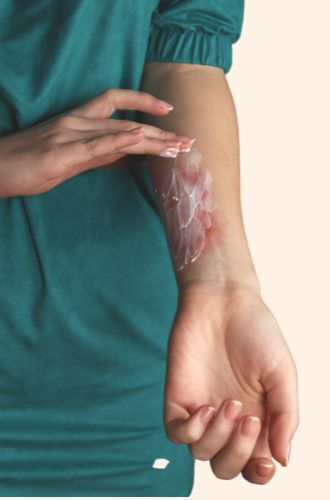
Burn deformities can be very serious, and can cause a great deal of physical and emotional pain. If you or someone you love has been suffering from a burn deformity, it’s important to seek out the best possible care. Dr. Nilesh Satbhai can provide you with the skilled and compassionate care you need to heal your burn deformity. Book your consultation today!
If not by patient survival, the severity of burn injuries or deformities is usually assessed by the consequence of burn injuries, i.e., scar hypertrophy/hyperplasia, structural deformities, and scar contracture due to loss of bodily components.
Since the physiological (bodily) deformity is closely related to the extent of injuries, restorative procedures are rarely indicated if the depth of injury is superficial and the burned area is limited but indicates deep burns. The probability of surviving burn injuries has changed greatly over the past 25-30 years.
Early wound debridement and wound coverage is an attributable approach in the surgical treatment of burn wounds. It is ironic that the successful outcome attained in burn treatment has resulted in an increased number of patients who will need to undergo reconstruction because of an aggressive ’life-saving’ surgical treatment.
Formation and contraction of scar tissues at the site of the wound are normal consequences of an injury. Thickened and contracted scar tissues mean the changes that are ’normal’ and ’expected’ are a consequence of the wound healing processes, which are microscopically composed of collagens arranged in nodules and whorls.
The changes might be observed as early as 3–4 weeks following the injury, and they are cosmetically unattractive and functionally disturbing.
Reconstructive procedures can considerably improve the function and appearance of the affected area. A burns survivor may benefit from a knowledgeable plastic surgeon who can select the best surgical treatment and also recommend physiotherapy.
Consult Dr. Nilesh Satbhai to find out if you are the right candidate for the treatment of post-burn deformities.
Request AppointmentA full history will be taken, including the cause, time of injury, and previous operations.
Consent will be taken for the use of the skin from the suggested donor areas.
A very careful examination of the deformed areas will be done regarding scarring, presence or absence of contractures, and if the patient has had any grafting operation before. Suggested donor areas (for the full thickness skin grafts) will be examined for the skin color, presence, and texture of hair. Photographing of the scars, contractures, and donor sites will be done for pre and post-operative purposes.
Following are some common procedures that are used to treat post-burn deformities:
Arthrodesis: This is a surgical procedure that involves the fusing of two pieces of bone together. This is often used to treat deformities in the joints, such as in the elbow or knee.
Skin grafts: This is a procedure where skin from another area of the body is transplanted to the area of the burn. This can help improve the burn’s appearance and heal the area more quickly.
Skin flaps: This is a procedure where skin and tissue are moved from one area of the body to another. This will not only make the burn look better, but it will also aid in healing the area.
Physiotherapy: This is a type of therapy that helps to improve the range of motion in the joints and muscles. This might aid in the individual’s mobility.
Splinting: This is a type of support that helps to keep the joints in place. This can help to prevent further deformities from occurring.
Dorsal hand: In dorsum hand deformity, there is clawing of fingers. Severe edema on the dorsum of the hand causes hyperextension of the MetaCarpoPhalangeal (MCP) joints. The palmar arches flatten. The ring and little fingers are mostly affected. The joints become rigid, and the extensor tendons undergo adaptive shortening.
The goal of treatment is to get your fingers straight, the MCP joints flexed, and facilitate the thumb to oppose the tips of the other fingers.
The other factor is the adaptive shortening of the extensor tendons. It’s better to stretch the muscles as much as possible, fix the joint, and further stretch the contracted muscles through physiotherapy. Cutting the tendon and putting on a tendon graft is not recommended.
Palm burns are less frequent compared to dorsal burns, and more often, they are superficial due to the thickness of palmer skin. Deep burns of the palm occur in camphor burns, industrial accidents, and electrical injuries.
The full release of palmar contracture is generally possible, and the raw area is covered by full-thickness or thick split-thickness grafts. It is good to use thick skin grafts in the palm rather than a flap. The thickness or bulkiness of the flap prevents cupping of the palm and the ability to hold objects. Flaps, if they are to be used, must be thin. Skin grafts provide better outcomes as they help in holding objects better.
If there is hyperextension contracture at the MetaCarpoPhalangeal (MCP) joint, swan neck-type deformity occurs in the thumb, and with flexion contracture at the MCP joint, a boutonniere deformity occurs. A burn swan neck deformity mainly occurs due to 3 causes. They are:
If the deformities are temporary and caused by skin contracture, then releasing the contractures will fix the issue. If the patient has severe deformities, then a plan must be made that is contingent upon which other fingers have similar deformations. At the same sitting, the thumb can be brought into a functional position by release of MCP joint contracture. Arthrodesis of the MCP joint can be performed if necessary. The degree and inclination of bone freshening can be used to position the thumb in the best possible orientation. In most circumstances, a functional and aesthetically acceptable thumb can be constructed utilizing a decent and sufficient first web and a sturdy MCP joint of the thumb.
This affects the function, and it needs to be corrected. The choice will depend on the cause of the deformity. If it is because of dorsal skin contracture, the doctor will release the incisions proximal and distal to the Proximal Interphalangeal (PIP) joint, and grafting will be done to correct the deformity. Similarly, mallet deformity correction will be done in the early stages. In most fixed deformities, the most favorable option would be the arthrodesis of the PIP joint in the functional position with an increase in flexion from the index to the little.
When circumferential burns of the fingers are allowed to heal without grafting, syndactyly may occur. The result of the separation of burns syndactyly depends on the depth and status of the burns of other parts of the fingers. Often, the longitudinal division must be made, and the areas will be grafted. When separating burn syndactyly, as much as possible, the best available skin is used to make the web flap. Full-thickness skin on the web prevents creep.
The little finger is the most affected in burn deformities. The deformity can either be a combination of flexion, rotation, loss of skin on the outer aspect of the finger, or even both.
Initial management is done to release the flexion and lateral contractures and get the finger out of the palm. If the finger is fully buried into the palm and the other fingers can easily be restored to normal functional position, then amputation of the deformed little finger might be an advantage over undergoing multistage procedures with residual compromised function.
The main benefit of post-burn deformities treatment is that it can help to improve the appearance of the burn and the individual’s range of motion. It can also help to prevent further deformities from occurring.
The cost of post-burn deformities treatment will depend on the severity of the deformities and the type of treatment that is required. Dr. Nilesh Satbhai will be able to give you a more accurate estimate of the cost after assessing the situation.
Request AppointmentThe potential complications of post-burn deformities treatment include infection, scarring, and nerve damage. These complications are rare but if they occur the doctor will be able to manage them effectively.

MBBS, MS, MCh
